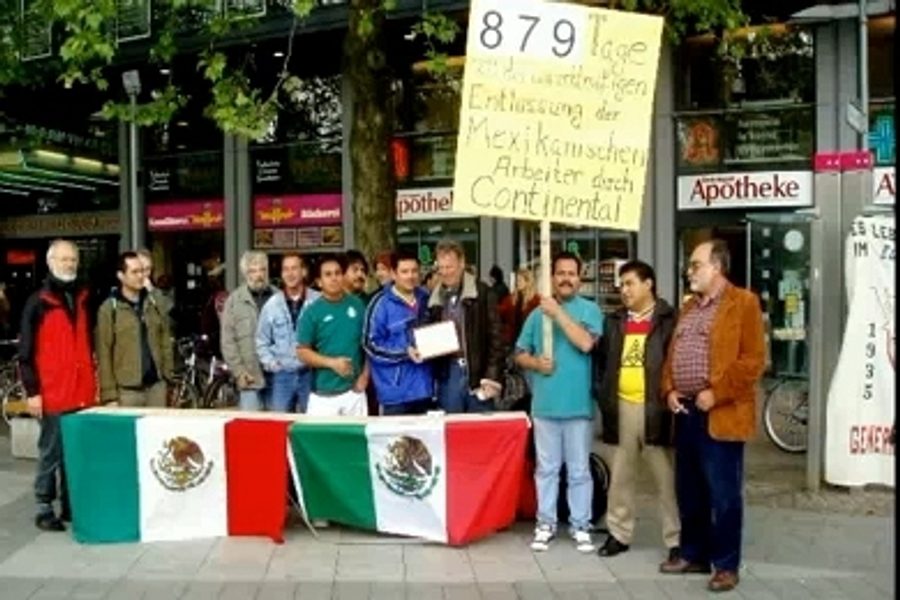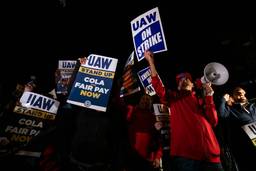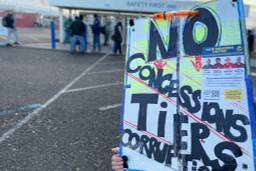
Part 1 of a two-part series on the TRADOC worker cooperative in Mexico, reprinted with permission from Labor Notes. Part 2, about how the co-op is functioning today, is available here at Labor Notes.
“If the owners don’t want it, let’s run it ourselves.” When a factory closes, the idea of turning it into a worker-owned co-operative sometimes comes up — and usually dies.
The hurdles to buying a plant, even a failing plant, are huge, and once in business, the new worker-owners face all the pressures that helped the company go bankrupt in the first place. Most worker-owned co-ops are small, such as a taxi collective in Madison or a bakery in San Francisco.
But in Mexico, a giant-sized worker cooperative has been building tires since 2005. The factory competes on the world market, employs 1,050 co-owners, and pays the best wages and pensions of any Mexican tire plant.
Aware that this unusual victory is virtually unknown in the U.S., friends in Guadalajara urged me to come down and see how the TRADOC cooperative is working.
Its president — who was union president when the plant was owned by Continental Tire — spoke in a workshop at the 2010 Labor Notes Conference. Jesus “Chuy” Torres is one of the more impressive unionists I’ve met — though he’s no longer officially a unionist. Still, “our class is the working class,” he told me.
Far from indulging in a “we’ve got ours” mentality, the TRADOC workers are intent on maintaining solidarity with workers still cursed with a boss.
It’s hard to decide which is more remarkable — how the Continental workers turned a plant closing into worker ownership through a determined 1,141-day campaign, or how they’ve managed to survive and thrive since then.
In any case, we need to celebrate such victories. I’ll tell the tale in two parts.
Opening the factory’s closed gates
Taking over their plant was not the workers’ idea. Continental Tire proposed to sell it to them — after the union backed management into a corner so tight the owners wanted nothing more to do with it.
But to get to that point workers had to wage a three-year strike and what we in the U.S. call a “comprehensive campaign.” Workers say it was not just one tactic that won the day, but a combination of relentless pressures.
Continental Tire, based in Germany, is the fourth-largest tire manufacturer in the world. It bought a factory in El Salto, outside Guadalajara in western Mexico, in 1998, intending to produce mainly for the U.S. market. When it was first built by the Mexican company Euzkadi in 1970, this was the most advanced tire-making plant in Latin America. It was still the most modern in Mexico by the early 2000s.
But Mexican tire-making plants were dropping like flies at that time: Goodyear, Uniroyal. NAFTA had caused tire imports from abroad to triple between 1996 and 2000. At Firestone, the company-dominated union accepted a 25 percent pay cut, multi-tasking, and a seven-day week to try to prevent a closure.
Most unions in Mexico are unions in name only, government-affiliated labor bodies whose functions are to collect dues and control workers.
But the Continental plant had a different history. Workers had had an independent, “red” union since 1935, SNRTE (National Revolutionary Union of Euzkadi Workers). A history of the union proudly tells the story of when Fidel Velasquez, top official of the corrupt government union CTM, came to their assembly in 1959 and asked that contract bargaining be put in his hands. Velasquez was expelled from the meeting “for being unworthy to be present in a workers’ assembly.”
Workers elected Chuy Torres and the Red Slate, which ran on a platform of resisting Continental’s demands, in 2001. Management had begun aggressively cutting costs the moment it bought the company, closing a sister factory in another state. It brought in a manager with experience in union-busting, José Neto Carvalho, who’d extracted huge concessions in Portugal.
Now Carvalho sent letters to all the workers’ homes, demanding seven-day production and a 12-hour day, a pay cut, speedup, job cuts, no more seniority for job bidding, and an end to the company-paid vans that brought workers to the plant.
Salvador (Chava) Hernandez, now retired, remembered, “We saw one thing and the company said the opposite. We were making 14,000 tires a day. The company said they weren’t selling, they were going bankrupt. The supervisors threatened us for months.”
But members refused to alter their contract. They didn’t believe management claims that their plant was unproductive, and they were well aware of the difference between their own salaries and those of Continental workers in Germany and the U.S.: a Mexican Continental worker made about $25 a day.
Closing shock
The evening of December 16, 2001, boiler room workers came to the plant and found a notice on the front gate: Closed.
They called union leaders immediately. Guards were mounted to keep management from taking out the machinery. Two days later an assembly was called, with almost all the 940 workers in attendance.
Management urged workers to take their legally owed severance pay and go home. In fact, managers had recruited a group of workers to try to convince others, promising a bounty of 10,000 pesos ($1,100) for each worker they persuaded. This group was promised they would be rehired first when the plant opened again.
When this scheme became known, it confirmed union leaders’ suspicion that Continental’s real plan was to get rid of the union, not the factory. It was the only independent union in the industry.
Workers voted to fight the closing, which they deemed illegal because management had acted suddenly, without following legal notification procedures and without proving the company was unprofitable. Torres later said that he really saw no way they could get Continental executives to change their mind, but he was determined to “give them a fight like they’d never imagined.”
The union officially began its strike — against a shuttered factory — a month later. Four thousand workers, families, and supporters marched nearly six miles from the El Salto city hall to hang red and black banners on the plant doors. Under Mexican law, these banners represent a strike, and nothing is allowed to be taken out of a plant during a strike. (This is one of several areas where Mexican labor law is superior to that in the U.S.)
A day earlier, Continental had brought a hundred trailers to the property, intending to remove the 70,000 tires inside. It posted armed guards on the roof, videotaping. Within a half-hour 200 workers and family members came to the plant to block the way.
The slogan they painted on a banner outside was “Not a Single Screw Is Leaving.” The workers’ demand was simple: that Continental honor its contract and keep the plant running.
To the capital
A week later, workers began a march to the national capital in Mexico City, taking a semi-circular route that led them nearly 500 miles (they used vans and buses most of the way) through seven states to locations where other workers were in struggle.
They held big public meetings with workers from GM, Nissan, General Tire, and Volkswagen, but the most emotional took place with campesinos in San Salvador Atenco, who were fighting (successfully) the government’s attempt to build an airport on their ancestral land. The campesino leader presented Torres with a machete as a token of friendship.
Along the way, the union secured a meeting with President Vicente Fox, a businessman whose election in 2000 had encouraged corporations to crack down on their employees. The workers demanded that the government nationalize the tire plant, as it had recently done with a sugar mill. Fox offered to help workers get a good financial settlement out of the closing, but Torres replied that what they wanted was their jobs.
When the workers arrived in Mexico City, they had 10,000 supporters behind them in the historic Zócalo, the main square.
International solidarity
Meanwhile, union leaders looked abroad for aid. The Continental local of the Steelworkers in Charlotte, North Carolina, offered no help; management threatened local leaders that if they did, their plant would close. It closed anyway.
Torres said the only aid SNRTE got from the U.S. union was a slogan: that the union would last “one day longer” than Continental. In the U.S. this slogan has most often been a substitute for strategy, but in Mexico it resonated with workers who were coming at the company from so many angles.
The same happened with the German chemical workers union that represented Continental workers. The head of the Continental works council openly said that the term “international solidarity” didn’t mean anything to him.
But SNRTE made other connections. Torres belonged to a socialist group with ties in Europe. Those connections helped SNRTE to meet with union leaders at tire plants and other factories in Spain. The European Parliament passed a resolution decrying human rights violations in Mexico by European multinationals, citing Continental. The union’s small delegation secured a five-minute meeting with Continental’s CEO, Manfred Wennemer — in which Wennemer blamed Torres for the factory’s closing.
The most exciting action was the workers’ visit to the Continental shareholders’ meeting. Through their leftist connections they met a group called “Critical Shareholders,” which organized to protest environmental and worker rights violations at various companies. That group gave their passes into the meeting to the Mexican delegation.
“My legs were shaking when I got up to speak in front of more than a thousand shareholders,” Torres said. But afterward Wennemer said he would tell his subordinates in Mexico to negotiate with the union. “It has to be in Mexico, though,” Wennemer said, according to Torres. “There’s no reason for you people to come here.”
Those negotiations were fruitless, though, and the next year the Mexicans were back in Germany. This time Wennemer felt obligated to justify the El Salto closing to the shareholders, calling the workers unproductive, with 25 percent absenteeism. Torres rebutted him with figures showing the plant was the most productive tire plant in the country.
The German minister of the economy called a meeting between the two sides, including the Mexican ambassador. A distinguished Mexican attorney explained how the closing had not complied with the law. The meeting raised the conflict’s international profile and demonstrated that Mexican authorities were not finding a solution.
On the workers’ third trip to Europe, in 2004, a Mexican congressman and a university labor law specialist accompanied them. The congressman asked the shareholders for a negotiated solution and that Continental respect Mexican labor law. His presence showed the shareholders that political circles in Mexico were paying attention. As it happened, German Chancellor Gerhard Schroeder and Fox would soon be meeting at a biennial Europe-Latin America summit — in Guadalajara, in the workers’ backyard.
The Mexicans and their allies in European human rights groups (still no support from the unions) were also making noise about Continental’s sponsorship of the upcoming World Cup in Germany. In downtown Hannover, site of Continental headquarters, the company had built a big monument with the World Cup symbol. The campaign demanded “fair play” in El Salto, promising to agitate at the World Cup itself if the conflict wasn’t resolved. Some of SNRTE’s 2004 delegation passed out flyers while others kicked a soccer ball around the monument.
Democracy spreads
Meanwhile, workers at Continental’s other factory in Mexico were restive. This General Tire plant was in San Luis Potosí, 200 miles from El Salto.
They’d had a company union that was pleased to cooperate with management’s plan to get rid of the union contract. In a dramatic meeting in April 2003, members voted out their officers and voted in a leader who’d been fired for resisting the secret agreement.
In July, while Wennemer was visiting Mexico, the San Luis Potosí workers struck. Wennemer scolded the local government for not using the police against them. But he fired his director general in Mexico.
And in January 2004, two years into the El Salto strike, the government finally declared the strike legal — making Continental liable for two years’ worth of back wages (another facet of Mexican law), a figure that would only grow the longer the strike lasted.
“We estimated the plant was worth $80 million,” Torres said. “And the back pay was $40 million.” This was in addition to the severance pay owed, which 587 workers had still refused to accept.
The tide was turning in favor of the workers.
Trials for families
Workers who stuck with the struggle endured many hardships. Some went to the U.S. to work. Other families relied on wives’ low wages. Local factory owners maintained a blacklist; even strikers’ family members could not get jobs. A wives’ group was fundamental to the struggle and spent much time locating different agencies and organizations that would donate food.
Conchita Velez de Hernandez was head of the women’s group. Her family was the backbone of those who stood guard at the factory gate. When the police threatened their husbands, she says, the wives went to the secretary of public security to protest. And they invaded the factory owners’ meeting to demand an end to the blacklist.
One of the more dramatic moments of the strike came in April 2002, during Holy Week, when management made one of two attempts to provoke violence by taking the tires and machinery out of the plant. The campesinos of Atenco, who were protecting their own boundaries, counseled sandbags. The campesinos journeyed to El Salto to help workers, wives, and supporters fill the bags with dirt and pile them in front of the plant.
During the whole length of the conflict, not a single screw was removed.
Cooperative victory
Germany is the second-biggest investor in Mexico, after the United States. Torres believes that, although the Mexican government was never an ally of their struggle, high-level politicians on both sides came to deem it better to get it over with.
In August 2004, less than three months after President Fox and Chancellor Schroeder met in Guadalajara, Wennemer made a serious offer. The company would sell the workers a half interest in the plant, in exchange for the back pay the company owed them.
Workers would still receive their severance pay, which totaled 230 million pesos for 587 workers, about $34,000 apiece. The plant would reopen in partnership with a Mexican company, a tire distributor, which would buy the other half from Continental. All the workers who’d held out would have their jobs back.
Torres seems as amazed by their victory as anyone. “The most important legacy of this struggle is to demonstrate to workers how a small union could beat a transnational of the capacity of Continental,” he said.
On February 18, 2005, the plant, now named Corporación de Occidente, or Western Corp., was formally handed over to its new owners.
“They were betting that we would fail,” Torres said.
But the workers didn’t fail. Read about their cooperative in Part 2.







